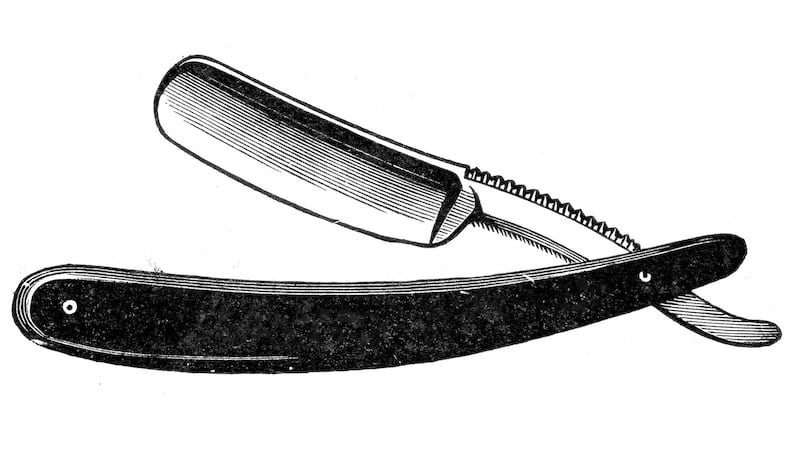Its proprietor was old, but active; William Callaghan, aged 90, operated the shop alongside his wife, Fanny, and with the help of a young woman named Anne Mooney.
They knocked on the barred door. Nobody answered. The lack of activity was unusual, but the locals took no action. When the shop remained closed the next day – Wednesday, January 9th, 1861 – they decided to investigate.
Four men gathered at the house - in which the shop was located - early in the morning. Finding, again, the front door locked, they climbed over the wall between the Callaghans’ garden and their next-door neighbours. The couple’s garden was normally kept in good order. That morning, both the back gate and back door stood open.
The locals went inside. A man named Morrison later recalled entering the couple’s bedroom, where he found the missing shopkeeper. The Irish Times reported that as the men proceeded up the stairs, “the horrible sight disclosed itself of old Callaghan, lying on the bed, the pillow over his face, and his throat severed from ear to ear”.
Mrs Callaghan's foot was propped against the door <br/>
Morrison left for the police barracks, and returned with a constable named James Garland, who was the first to pull the pillow from the dead man’s head. Boxes were open and papers were scattered about. In a desk, Garland found a pocket book with some money remaining inside, which he took as evidence. Reports were quick to note the severity of the wound and the bloodiness of the scene. Another constable, Richard Holmes, would soon discover a blood-covered brick in the bed.
The men searched for Mrs Callaghan. The house was a two-storey building; the Callaghans operated the shop on the ground floor and lived on the first. Downstairs, the search party found it difficult to open the door into the main shop area. The cause of the obstruction was soon discovered – Mrs Callaghan’s foot was propped against the door – she had suffered the same fate as her husband and was found lying dead behind a counter. The shop, like the bedroom, was ransacked, with a small amount of money left in the till.
There was a third person still missing; Anne Mooney’s bedroom was undisturbed and empty. “They knew there was a servant, they had not seen her; they accordingly left the shop, and proceeded to the coal-hole, and the victim of this unhallowed massacre was there found and she also was quite dead,” reads a report in The Irish Times.
Anne was dead in the coal shed, laying on her left side with her head towards the coals. Like her employers, her throat was cut. A blunt instrument had caused severe damage to her head. A coal scoop lay near the body, one report said, “as if she had been out getting coal”. Her hand remained raised, apparently in a final act of defence.
The state of the shop and living quarters told police the house was the scene of both a murder and a robbery. As they sifted through the house for clues that morning, their soon-to-be chief suspect was being released from police custody 25km away, in Sligo town.
Shopping spree
On Tuesday afternoon, a day before the discovery of the Ballymote bodies, a young man named Matthew Phibbs was on something of a shopping spree in Sligo. At about 2 or 3pm, he bought a pair of boots at a shop owned by a man named Sleator. While there, the proprietor asked about some blood dappled on the customer’s arm. Phibbs said it was his; that something had just then nicked him when he put his hands in the new boots.
Moving on, he visited another establishment on Market Street, this time buying a new coat and cap and leaving his old hat in the possession of the shopkeeper. Phibbs had first discarded it in the street, but the shopkeeper called him back – it was a decent hat, he said, and a poor person might make use of it. Phibbs then visited a third store to have his razor ground – it was in terrible order, with the blade severely gapped. The customer said a neighbour’s child had been using it to cut sticks, hence the wear and tear.

After that, Phibbs went drinking. Later again, he was picked up and arrested for drunkenness.
At that point on Tuesday night, there was no talk of murder in the county – it would be the following morning that Morrison ascended the stairs in Ballymote. So, when a police search in Sligo uncovered gold, silver and more than £20 in blood-spattered banknotes in the pockets of a drunk Matthew Phibbs, it did not raise the level of suspicion it warranted. His clothes, too, were bloodstained.
The money, along with a couple of razors, were returned to Phibbs on his release at 6am on Wednesday morning, after he’d sobered up.
By 3pm, he was under arrest again, this time on suspicion of murder. Police picked Phibbs up for the second time at Riverstown, not far from Ballymote, in the doorway of Pat Conway's public house. He wore a distinctive blue coat. In the pub, police discovered a parcel with another coat bearing a "Market Street" label.
At this point, Phibbs was the main suspect. A few days later on Saturday, January 12th, he was sent forward for trial at the following assizes in March. He pleaded not guilty. The motive for the murder according to the crown, was money.
‘Dead man’s coat’
The police investigation dug up some circumstantial evidence, including witnesses placing Phibbs near the scene. The blue coat Phibbs was arrested in was said to have been “the dead man’s coat”. The prosecution also pointed to Phibbs’s apparent sudden financial resurrection following the murder.
Legal documents from 1861 detail the witnesses’ accounts. Among those who gave evidence were a couple of workers who said they saw Phibbs skulking around at the back of the Callaghan’s property prior to the grim discovery – he was seen perching on the four-foot dividing wall (over which the neighbours would climb on the morning the bodies were found).
Three other people were arrested and later released. Case files reveal that one of them, a former employee of the Callaghans named Edward Balfe, was instrumental in linking Phibbs to the crime. He said the blue coat worn by Phibbs belonged to the elderly shopkeeper who had been found dead. Balfe himself often cleaned it as part of his duties before he was let go. A second servant identified the coat.
Clothing became essential to the case. The tailor who made the blue coat for Mr Callaghan was called to provide the measurements he had recorded for the garment. The shopkeeper who had sold Phibbs the new cap in Sligo produced the old hat Phibbs had thrown in the street – the same one he would have worn while committing the murder and surveying the house.
Essential, too, was Phibbs's financial history. The court heard that Phibbs had sent letters to neighbours asking for money. An auctioneer said in the summer of the previous year, Phibbs employed him to help sell the remaining stock in his failing shop, before eventually moving to England for a time.
“He had difficulties with his creditors,” the auctioneer told the court. These difficulties, the prosecution said, abruptly stopped after the death of the Callaghans, after which he paid off a debt to a publican named Mrs Flaherty, before hitting Sligo with more than £20 in his pocket and clothes to buy.
The evidence was circumstantial, and the jury was told as much by the judge when charged.
Phibbs was tried twice. He was spared conviction in March 1861 when one of the 12 jurors could not decide. (Reports said the other 11 had arrived at a “guilty” verdict.) At his second trial that summer, the “Ballymote Slasher” - as he has since been commonly called - was found guilty. The judge sentenced him to hanging on August 19th, 1861.
In three days, she will be childless, and her erring son past repentance <br/>
Mary Phibbs, his mother, petitioned the Lord Lieutenant in the days before the scheduled execution. An appeal for her son’s life, written on behalf of Mary and dated August 16th, 1861, asked that his sentence be reduced to life imprisonment. The letter cited Matthew’s youth (he was about 25) as grounds for reducing his punishment, along with the use of circumstantial evidence about which a previous jury disagreed.
“In three days, she will be childless, and her erring son past repentance,” it said. “May the almighty God of Mercy incline Your Excellency’s heart to grant the petition of his broken hearted mother.”
The Lord Lieutenant declined the appeal.
Matthew Phibbs was hanged that August. Newspaper reports at the time describe an agonising, drawn-out process on the morning of August 19th. Crowds gathered outside Sligo gaol to spectate.
To begin with, the sheriff, Bernard Owen Cogan, delayed the execution that morning until after the arrival of the mail from Dublin – anticipating, perhaps, a late reprieve for Phibbs. No such notice arrived from the Lord Lieutenant.
The unnamed executioner was nervous. The Kerry Evening Post reported that when the executioner met Phibbs, the hangman was timid and hid behind a door.
Young men, beware of what has brought me to this, my untimely end <br/>
Phibbs struggled, according to multiple reports, and he lived for two minutes after the drop. The Post reported: "A policeman and several of those in the crowd fainted.”
Before his execution, Phibbs had turned to religion. At one point, he also asked for writing materials, which he used to pen a full confession.
In the letter, Phibbs said he had a good upbringing and issued a warning to young men to avoid making his mistakes.
“Yes, often my parents did advise me to mind my Sunday-school and Church, but I did neglect them, and went to whiskey-houses and play-houses, and races,” he wrote. “Again, young men, beware of what has brought me to this, my untimely end.”












